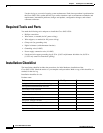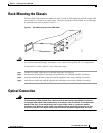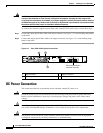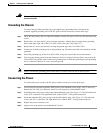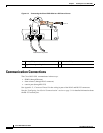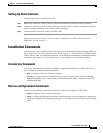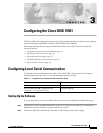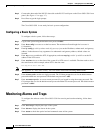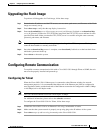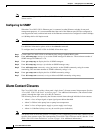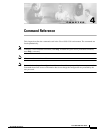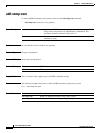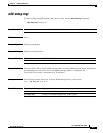
3-2
Cisco ONS 15501 User Guide
78-14134-02, Release 2.0
Chapter 3 Configuring the Cisco ONS 15501
Monitoring Alarms and Traps
Step 3 Connect the other end of the RS-232 data cable to the RS-232 serial port on the Cisco ONS 15501 front
panel. (See Figure 1-2 on page 1-7.)
Step 4 Press Enter to get the login prompt.
The Cisco ONS 15501 is now ready for basic system configuration.
Configuring a Basic System
To configure a basic system, follow these steps:
Step 1 Log in to the system using the default master password edfa1.
Step 2 Enter host-config hostname to set the host name. The maximum allowed length for hostname is
15 characters.
Step 3 Enter ip-config ip-addr ip-subnet-mask def-gateway-ip to set the IP address, subnet mask, and gateway
address. In the absence of any arguments for subnetmask and gateway address, default values are
inserted.
Step 4 Enter ntp status to enable the NTP, if appropriate, and enter ntp-ip ip-addr1 ip-addr2 to set the IP
address of the NTP server.
Step 5 Enter set-time time to set the time of the system if no NTP server is available. The time needs to be in
the same format as this example, where PST is the time zone.
Fri Aug 24 10:50:31 2001 PST.
Note See Appendix D, “Time Zone Codes,” for a list of time zones and correlating abbreviations.
Step 6 Enter set-user-pwd to set the user login password. The CLI then prompts the user for the default master
password and the new user password. The default user password is edfa.
Step 7 Enter set-master-pwd to set a new master password if you logged in using the master password. The
CLI prompts the user for the default master password and the new master password. The default master
password is edfa1.
Monitoring Alarms and Traps
To configure the software on the Cisco ONS 15501 for console port-based monitoring, follow these
steps:
Step 1 Enter show-trap to display the traps of the system.
Step 2 Enter alarm to display the alarms in the system.
Step 3 Enter status to check the optical and environmental status of the system.



